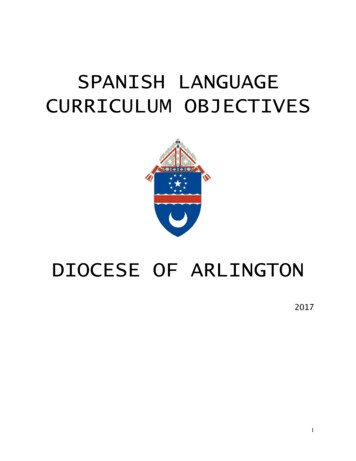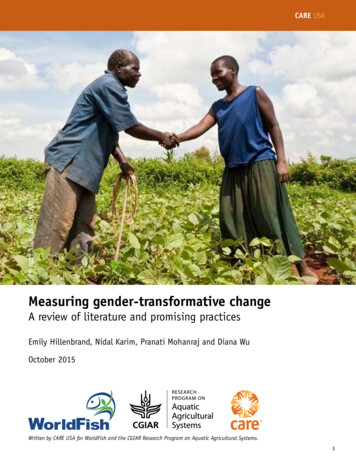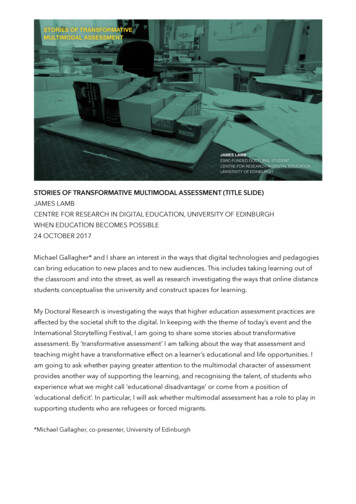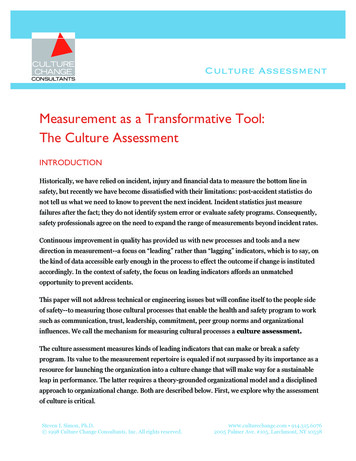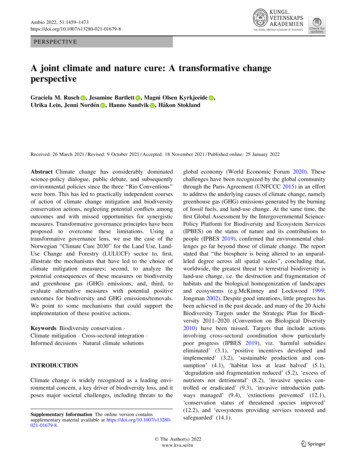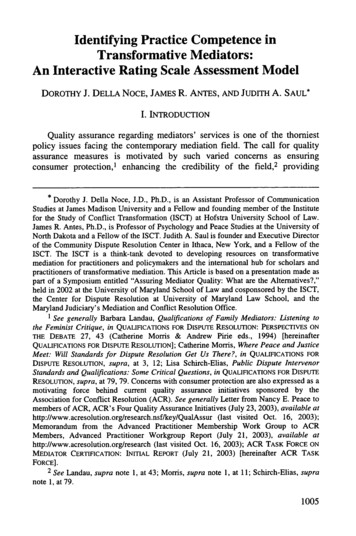
Transcription
Identifying Practice Competence inTransformative Mediators:An Interactive Rating Scale Assessment ModelDOROTHYJ.DELLA NOCE, JAMESR. ANTES,AND JUDITH A. SAUL*I. INTRODUCTIONQuality assurance regarding mediators' services is one of the thorniestpolicy issues facing the contemporary mediation field. The call for qualityassurance measures is motivated by such varied concerns as ensuringconsumer protection,' enhancing the credibility of the field,2 providing* Dorothy J. Della Noce, J.D., Ph.D., is an Assistant Professor of CommunicationStudies at James Madison University and a Fellow and founding member of the Institutefor the Study of Conflict Transformation (ISCT) at Hofstra University School of Law.James R. Antes, Ph.D., is Professor of Psychology and Peace Studies at the University ofNorth Dakota and a Fellow of the ISCT. Judith A. Saul is founder and Executive Directorof the Community Dispute Resolution Center in Ithaca, New York, and a Fellow of theISCT. The ISCT is a think-tank devoted to developing resources on transformativemediation for practitioners and policymakers and the international hub for scholars andpractitioners of transformative mediation. This Article is based on a presentation made aspart of a Symposium entitled "Assuring Mediator Quality: What are the Alternatives?,"held in 2002 at the University of Maryland School of Law and cosponsored by the ISCT,the Center for Dispute Resolution at University of Maryland Law School, and theMaryland Judiciary's Mediation and Conflict Resolution Office.1 See generally Barbara Landau, Qualifications of Family Mediators: Listening tothe Feminist Critique, in QUALIFICATIONS FOR DISPUTE RESOLUTION: PERSPECTIVES ONTHE DEBATE 27, 43 (Catherine Morris & Andrew Pirie eds., 1994) [hereinafterQUALIFICATIONS FOR DISPUTE RESOLUTION]; Catherine Morris, Where Peace and JusticeMeet: Will Standards for Dispute Resolution Get Us There?, in QUALIFICATIONS FORDISPUTE RESOLUTION, supra, at 3, 12; Lisa Schirch-Elias, Public Dispute IntervenorStandardsand Qualifications:Some Critical Questions, in QUALIFICATIONS FOR DISPUTERESOLUTION, supra, at 79, 79. Concerns with consumer protection are also expressed as amotivating force behind current quality assurance initiatives sponsored by theAssociation for Conflict Resolution (ACR). See generally Letter from Nancy E. Peace tomembers of ACR, ACR's Four Quality Assurance Initiatives (July 23, 2003), available lAssur (last visited Oct. 16, 2003);Memorandum from the Advanced Practitioner Membership Work Group to ACRMembers, Advanced Practitioner Workgroup Report (July 21, 2003), available athttp://www.acresolution.org/research (last visited Oct. 16, 2003); ACR TASK FORCE ONMEDIATOR CERTIFICATION: INITIAL REPORT (July 21, 2003) [hereinafter ACR TASKFORCE].2 See Landau, supra note 1, at 43; Morris, supra note 1, at 11; Schirch-Elias, supranote 1, at 79.1005
OHIO STATE JOURNAL ON DISPUTE RESOLUTION[Vol. 19:3 20041marketing advantages to individual practitioners, 3 and increasing publicdemand for mediation services. 4 Yet at the same time, the prospect of qualityassurance procedures often stirs heartfelt debate about the professionalization7of the field,5 premature institutionalization, 6 reduced access to the field,standardization, 8 and hegemony. 9 While the motivations to provide qualityassurance measures are creditable, the sources of resistance highlightsignificant concerns about the potential impact of such measures on a stilldeveloping field of endeavor and those whom that field serves.Despite the debate, a wide variety of quality assurance processes haveevolved. Professors Sarah Cole, Nancy Rogers, and Craig McEwen catalog apatchwork of processes in place in various jurisdictions throughout thecountry. These processes include entry-level qualifications based oneducational degrees, training, or experience; performance-based standards;mediator liability and immunity schemes; certification and decertificationschemes; codes of ethics; and regulatory approaches. 10 Of these, onlyperformance-based assessment directly addresses the practice competence ofmediators-the ability to perform the role of mediator competently in thecourse of the unfolding interaction of a mediation session. Nonetheless, it is3 This motivation typically underlies quality assurance efforts by professionalorganizations. See, e.g., Letter from Nancy E. Peace, supra note 1; Memorandum fromthe Advanced Practitioner Membership Workgroup Report, supra note 1; ACR TASKFORCE, supra note 1.4 See Morris, supra note 1, at 12.5 See id. at 16-17.6Seeid. at 19.7 Michelle LeBaron Duryea, The Quest for Qualifications:A Quick Trip Without aGood Map, in QUALIFICATIONS FOR DISPUTE RESOLUTION, supra note 1, at 109-10(expressing concern that the push for qualifications and standards in the mediation fieldwill lead to "replication of the status quo where processing of disputes is carried outprimarily by dominant culture professionals according to dominant culture, middle classvalues"); Eric B. Gilman & David L. Gustafson, Of VORPs, VOMPs, CDRPs andKSAOs: A Case for Competency-Based Qualificationsin Victim Offender Mediation, inQUALIFICATIONS FOR DISPUTE RESOLUTION, supra note 1, at 89, 93-94 (arguing that theprocess of establishing mediator qualifications is extending the hegemony of the legalsystem, and the "white male lawyers" who have become legislators and judges).8 See Morris, supra note 1, at 7.9 See Duryea, supra note 7, at 110; Gilman & Gustafson, supra note 7, at 94; Morris,supra note 1, at 6.10 SARAH R. COLE ET AL., MEDIATION: LAW, POLICY AND PRACTICE §§ 11.2-11.6(2d ed. 2001).1006
TRANSFORMATIVE MEDIATOR COMPETENCEsafe to say that performance-based assessment methods remain the least12developed in the field1 1 and possibly the most criticized as well.In this Article, we describe and explain a quality assurance model formediators called the Interactive Rating Scale Assessment-an interactive,performance-based approach that is directed toward the summativeassessment 13 of practice competence in mediators who follow thetransformative framework. 14 We begin with the historical and conceptualbackground of this project in Part II. From our review of the history ofperformance-based assessment initiatives in the mediation field, we identifythree key deficiencies in the early attempts at establishing performance-basedassessment methods that we believe generated valid criticism: inadequatetheoretical grounding, inadequate empirical grounding, and inadequatemethodological grounding. In Part III, we lay the groundwork for our processby articulating our own theoretical, empirical, and methodological11 According to Cole et al., "the widespread adoption of performance-basedstandards appears uncertain and distant." Id. § 11.2.12 Many of these criticisms were expressed in Who Really is a Mediator?A SpecialSection on the Interim Guidelines, 9 NEGOT. J. 293 (1993). See generally Robert A.Baruch Bush, Mixed Messages in the Interim Guidelines, 9 NEGOT. J. 341, 342 (1993);Robert Dingwall, Does Caveat Emptor Alone Help Potential Users of Mediation?, 9NEGOT. J. 331, 334 (1993); Deborah M. Kolb & Jonathan E. Kolb, All the Mediators inthe Garden, 9 NEGoT. J. 335 (1993); David E. Matz, Some Advice for MediatorEvaluators, 9 NEGOT. J. 327, 327-30 (1993); Craig A. McEwen, Competence andQuality, 9 NEGOT. J. 317, 318 (1993); Carrie Menkel-Meadow, Measuring Both the Artand Science of Mediation, 9 NEGOT. J. 321, 321 (1993); Richard A. Salem, The InterimGuidelines Need a Broader Perspective, 9 NEGOT. J. 309 (1993); Susan S. Silbey,Mediation Mythology , 9 NEGOT. J. 349 (1993); see also, Duryea, supra note 7, at 10929; Morris, supra note 1, at 3-24; Cheryl A. Picard, The Emergence of Mediation as aProfession, in QUALIFICATIONS FOR DISPUTE RESOLUTION, supra note 1, at 141-63;Andrew Pirie, Manufacturing Mediation: The Professionalization of Informalism, inQUALIFICATIONS FOR DISPUTE RESOLUTION, supra note 1, at 165-91.13 "Summative assessment" refers to assessment performed at the conclusion of acourse of instruction in order to determine whether the goals of instruction were met. SeeD. Royce Sadler, Formative Assessment and the Design of Instructional Systems, 18INSTRUCTIONAL SCIENCE 119, 120 (1989); see also Northern Illinois University,Assessment Services "Assessment Term Glossary," at http://www.niu.edu/assessment/resourc/gloss.shtml (last visited Feb. 9, 2004); David R. Carless, Unleashing the Potentialof Assessment for Learning, Paper presented at the Symposium, "Learning from the Past,Informing the Future: Education, Then, Now and Tomorrow," supported by the Councilof the Lord Wilson Heritage Trust, held at Hong Kong Baptist University, May 13-14,2002.14 The transformative approach was articulated by Robert A. Baruch Bush andJoseph P. Folger. See ROBERT A. BARUCH BUSH & JOSEPH P. FOLGER, THE PROMISE OFMEDIATION 12, 102-04 (1994).1007
OHIO STATE JOURNAL ON DISPUTE RESOLUTION[Vol. 19:3 2004]foundations. In Part IV, we discuss the discourse patterns that characterizecompetent transformative mediation practice. We then describe theInteractive Rating Scale Assessment in Part V, including how it is best usedand the evidence for its validity and reliability. We conclude, in Part VI, witha discussion of the implications of this model for the future of performancebased assessment initiatives in the mediation field generally.II. HISTORICAL AND CONCEPTUAL BACKGROUNDA. The ISCT ProjectThe Interactive Rating Scale Assessment we present here is one productof a larger endeavor by the Institute for the Study of Conflict Transformation(ISCT) 15 to develop approaches for supporting and assessing mediatorcompetence in the transformative framework. This work began as part of thePractice Enrichment Initiative (PEI), a multi-pronged theory-to-practiceproject led by Professors Robert A. Baruch Bush and Joseph P. Folger, which16was jointly funded by the Hewlett Foundation and the Surdna Foundation.The PEI, which began in 1998 and ended in 2000, encompassed three workgroups: one that focused on developing "pictures of practice" through closeanalysis of transformative mediation practice using videotapes andtranscripts of mediation sessions; another that studied approaches to mediatordevelopment and assessment; and a third that analyzed policy materials in themediation field to assess their impact on the opportunity to engage intransformative practice and to develop appropriate alternatives wherenecessary. 17 Among the many products of the PEI were: (1) the recognitionof the profound impact of policy materials, such as assessment standards andprocedures, on practice; (2) a crystallization of images of competenttransformative practice; and (3) thoughtful approaches and materials forformative assessment-a supportive, developmental approach to building18mediator competence in the transformative model.15 The Institute for the Study of Conflict Transformation is a think tank, affiliatedwith the Hofstra University School of Law that is dedicated to developing anddisseminating resources on the transformative framework to practitioners, policymakers,and others interested in the mediation field.16 Robert A. Baruch Bush & Joseph P. Folger, The Practice Enrichment Initiative1998-2000 FinalReport (2001).17 Id.18 See generally James R. Antes & Judith A. Saul, Evaluating Mediation Practicefrom a Transformative Perspective, 18 MEDIATION Q. 313 (2001) [hereinafter, Antes &Saul, Evaluating]; James R. Antes & Judith A. Saul, Staying on Track with1008
TRANSFORMATIVE MEDIATOR COMPETENCEDuring this same time period, members of the ISCT were activelyengaged in the education and training of mediators-as they are today. Asignificant component of these training programs involved ongoingassessment of the practices of mediators during the training process in orderto determine those areas where adequate learning was demonstrated, as wellas those areas where additional instruction was needed. This assessment wasconducted through close analysis of the mediators' interactions in mediationsimulations. Eventually, to meet the demand for training beyond theintroductory level, members of the ISCT developed an advanced tutorialtraining (also known as a coaching process) that utilized close analysis withmediators of videotaped interactions of those mediators in mediationsimulations. This training process was developed in tandem with the work of19Professor James R. Antes and Judith A. Saul on formative assessment.Upon the conclusion of the PEI, we turned our attention towardsummative assessment, that is, a summary evaluation at a specific point intime of a mediator's competence in transformative practice. 20 Because ourTransformative Practice: How Do We Know if Mediators Have Internalized theFramework?, Presentation at the Hamline University 1999 Symposium on / initiatives.htm (last visited Feb. 7, 2004)[hereinafter Antes & Saul, Staying].19 See generally Antes & Saul, Evaluating, supra note 18; Antes & Saul, Staying,supra note 18.20 The summative assessment work of the ISCT was and is motivated by a variety ofconcerns. First, there is a desire to be responsive to and support the many programadministrators who have consistently voiced a need for summative assessmentapproaches to support their own local quality control efforts. Second, there is a need toprotect the integrity of the transformative model and minimize the potential for confusionamong various models by providing a means for assessing whether practitioners andprograms going by the name "transformative" are truly engaged in transformativepractice. The third concern is related to the second: providing a way to assess whethermediators are actually engaged in transformative practice supports the possibility of validand reliable research into the effects of transformative mediation. Fourth, there is a desireto protect the ability of mediators to use the transformative model by offering anassessment alternative for those programs that are currently using assessment processesbased solely on the problem-solving model. While the developers and administrators ofsuch programs may not intend to exclude transformative mediators from their ranks, theysometimes exclude transformative mediators nonetheless because they adopt assessmentprocesses that capture only problem-solving competencies. Finally, the ISCT has beenapproached by organizations that seek access to a roster of mediators who are competentin the transformative approach. It is within the ISCT mission of supporting the field, andthe mission of mediators who wish to engage in transformative practice, to develop suchrosters. This requires a thoughtful process for determining practice competence.1009
[Vol. 19:3 20041OHIO STATE JOURNAL ON DISPUTE RESOLUTIONinterest was in practice competence, we explored performance-basedassessment methods. We looked critically at what had already beenattempted in the field, considered the concerns voiced by various scholarsand practitioners, and sought to develop a process that addressed thoseconcerns. In the process, we brought together the insights from the PEIproject, our experiences with training and coaching, and new insights from21empirical research on the discourse of competent transformative mediators.At the 2002 Symposium of the Institute for the Study of ConflictTransformation, entitled Assuring Mediator Quality: What are theAlternatives? at the University of Maryland School of Law in Baltimore, wepresented a Provisional Summative Assessment Process 22 and invited publiccomment. Participants at the Symposium were generous with theircomments, insights, and suggestions. 23 Following the Symposium, we madea number of revisions to the model and tested it for reliability. In the springof 2003, the ISCT launched a performance-based mediator certificationprogram utilizing the Interactive Rating Scale Assessment. 24 With thehistorical background of this project articulated, in the next section wepresent the conceptual background, by reviewing the history of performancebased assessment in the mediation field.B. Performance-BasedAssessment in the MediationFieldThe basic premise of performance-based assessment is rather simple:identify what competent mediators do, and then observe mediators in actionto determine whether they demonstrate competence by doing it. The earliestattempt to identify what competent mediators do for the purpose ofdeveloping a method of assessment is generally traced to Christopher25Honeyman.21 See generally DOROTHY J. DELLA NOCE, IDEOLOGICALLY BASED PATrERNS IN THEDISCOURSE OF MEDIATORS:ATRANSFORMATIVE PRACTICE (2002).22 NDal.,Identifying CompetenceinTransformative Mediators: A Provisional Summative Assessment Process, Presentationfor the 2002 Symposium of The Institute for the Study of Conflict Transformation (Dec.8-9, 2002).23 We thank all who have contributed to the development of this project, includingour colleagues at the ISCT and the participants at the Symposium.24Information on the ISCT Certification Program can be found athttp://www.transformativemediation.org (last visited Feb. 7, 2004).25 See Christopher Honeyman, Five Elements of Mediation, 4 NEGOT. J. 149, 149(1988).1010
TRANSFORMATIVE MEDIATOR COMPETENCEWhile conducting on-the-job training of mediators within the WisconsinEmployment Relations Commission (WERC), Honeyman observed thattrainees were likely to encounter vast differences in the working styles ofvarious mediators, which caused certain practical difficulties. To addressthese difficulties, in 1985-86 he undertook a study designed to find out ifthere was a common matrix of basic skills that could be used to explainmediator practice generally and to inform mediation training programs inparticular. First, he identified five mediators who met two criteria:"demonstrated consistency of results, and the maximum possible variation ofcharacter and known style of mediation."2 6 Honeyman then observed a totalof sixteen mediation sessions conducted by members of this group ofmediators. He interviewed the mediators before and after the mediationsessions and made notes of his observations during the sessions. Heconcluded that all mediators studied engaged in five generic types ofactivities: investigation, empathy, persuasion, invention, and distraction. Theresults of this study were then used to develop training materials to teachtoward each of the five dimensions as well as to create assessment scales forevaluating the performance of mediator candidates in a mediation role-playsimulation.In 1987, concerns with quality control in the mediation field led theSociety of Professionals in Dispute Resolution (SPIDR) to establish aCommission on Qualifications. In its 1989 Report, the Commissionconcluded that quality control standards for mediators should be"performance-based," that is, built on understanding what mediators actuallydo in the course of mediation practice and how they do it, rather thanidentified with any particular degree or educational background.2 7 In itsReport, the Commission cited Honeyman's effort at identifying"performance-based" criteria for the selection and training of mediators as anexample of the type of criteria it endorsed. 28 With this endorsement, thestudy Honeyman conducted in 1985-86 inspired more than a decade of29follow-up work.26 Id. at27See152.COMMISSION ON QUALIFICATIONS, SOCIETY OF PROFESSIONALS IN DISPUTERESOLUTION, QUALIFYING NEUTRALS: THE BASIC PRINCIPLES 3 (1989).28 See id. at 15-16.29 See, e.g., TEST DESIGN PROJECT, INTERIM GUIDELINES FOR SELECTING MEDIATORS2 (1993) [hereinafterTEST DESIGN PROJECT, INTERIM GUIDELINES]; TEST DESIGNPROJECT, PERFORMANCE-BASED ASSESSMENT: A METHODOLOGY FOR USE IN SELECTING,TRAINING, AND EVALUATING MEDIATORS 2 (1995) [hereinafter, TEST DESIGN PROJECT,PERFORMANCE-BASED ASSESSMENT]; Christopher Honeyman, The Common Core ofMediation, 8 MEDIATION Q. 73, 73 (1990); Christopher Honeyman, On Evaluating1011
OHIO STATE JOURNAL ON DISPUTE RESOLUTION[Vol. 19:3 2004]Most of the follow-up work on Honeyman's project took place under theauspices of the Test Design Project, a grant-funded initiative with the goal ofdescribing the essential elements of mediation practice in order to createstandardized rating scales for evaluating mediators. To develop measurementscales for core mediator competencies in a rapid and economical way, theTest Design Project team built upon the original scales developed byHoneyman, but modified them using a "consensus" process. First, the groupcompiled a list of tasks expected of mediators by studying training manualsand job descriptions. Then, the group discussed and amended what it hadcompiled, reaching an agreed list of knowledge, skills, abilities, and otherattributes necessary for competent mediation practice. In 1993, the TestDesign Project released the Interim Guidelines for Selecting Mediators30(hereinafter Interim Guidelines).A special issue of Negotiation Journal dedicated to commentary on theInterim Guidelines followed. 31 While some of the commentary lauded theguidelines as a service to the field and the public, 32 criticism of theassumptions, methods, and consequences of the Interim Guidelinesabounded. Notably, the overwhelming weight of critique directed toward thework of the Test Design Project was that it did not account for the diversity33of practice in the field.In 1995, the Test Design Project issued its final report, PerformanceBased Assessment: A Methodology for Use in Selecting, Training andEvaluating Mediators,34 which replaced the Interim Guidelines. In thisreport, the Test Design Project team directly addressed the issue of thediversity of practice in the mediation field. The team acknowledged thechallenge of resolving the different approaches to mediation on one set ofcompetency scales, and reframed the goal from providing universal,standardized scales to providing a "methodology" for assessment. The TestDesign Project team claimed in its final report that it presented at best amethodology-not fixed substantive standards for competency. The teamrecommended that each mediation program identify the skills it deemedessential to competence and modify the scales proposed by the Project teamMediators, 6 NEGOT. J. 23, 24 (1990); Brad Honoroff et al., Putting Mediation Skills tothe Test, 6 NEGOT. J. 37, 37 (1990).30 TEST DESIGN PROJECT, INTERIM GUIDELINES, supra note 29.31 See supra note 12.32 See generally Dingwall, supra note 12; Menkel-Meadow, supra note 12.33 See, e.g., Bush, supra note 12, at 343-44; Duryea, supra note 7, at 116-20; Kolb& Kolb, supra note 12, at 335-36; McEwen, supra note 12, at 317-19; Morris, supranote 1, at 5-6.34 TEST DESIGN PROJECT, PERFORMANCE-BASED ASSESSMENT, supra note 29.1012
TRANSFORMATIVE MEDIATOR COMPETENCEaccordingly to customize a set a scales consistent with its own values andpriorities. Hence, the Project team's final product was not a valid and reliabletest of mediator practice competence. Validity was in question because of thelack of evidence that what the test claimed to be measuring---competentmediation practice-was what it actually measured. On one hand, themultiple variant scales offered by the Test Design Project, and therecommendation that mediation programs customize their own scales,threatened validity by suggesting that competent mediation practice could notbe precisely defined and measured. On the other hand, validity wasthreatened by the lack of empirical evidence to support the scales. Reliability,defined as "consistency of observation, labeling, or interpretation," 35 waslikewise threatened by the recommendation of customization, whichsuggested that if different practitioners could define mediation differently,then different assessors could as well. Hence, quality of mediation practicewas in the eyes of each individual assessor and consistency of judgmentwithin the community of assessors was doubtful.A number of performance-based tests that have followed the Test DesignProject-what Professor Bush calls the "progeny of the TDP test"-are"similar in character and purpose." 36 A thorough review of each of these testsis beyond the scope of this Article. 37 However, because these tests are basedupon essentially the same fundamental assumptions and approach as the TestDesign Project test,38 they suffer from the same questionable validity andreliability. For purposes of this Article, we will closely analyze only the caseof the Test Design Project, and use it as an exemplar of problems faced byefforts to develop performance-based testing in the mediation field generally.We suggest that the problem faced by the Test Design Project was notthe concept of performance-based assessment per se, 39 but rather how thatconcept was executed. Specifically, we suggest that the foregoing efforts todevelop a performance-based assessment process were hampered by: (1)inadequate theoretical grounding, (2) inadequate empirical grounding, and35 SeeRICHARDE.BOYATZIS,TRANSFORMINGTHEMATIC ANALYSIS AND CODE DEVELOPMENTQUALITATIVEINFORMATION:144 (1998).36 Robert A. Baruch Bush, One Size Does Not Fit All: A PluralisticApproach toMediator Performance Testing and Quality Assurance, 19 OHIO ST. J. ON DiSP. RESOL.974-81 (2004).37 Id. (reviewing and analyzing these tests).38 Id.39 Note that the ACR Task Force on Certification reached a contrary conclusion. Inits report to the ACR Board of Directors, the Task Force on Certification discouraged theuse of performance-based testing because of the "cost . and possible unreliability." SeeACR Task Force on Mediator Certification, Initial Report, supra note 1.1013
OHIO STATE JOURNAL ON DISPUTE RESOLUTION[Vol. 19:3 2004](3) inadequate methodological grounding. We elaborate each of thesedimensions in the paragraphs that follow.First, the above efforts to develop performance-based assessmentmethods were hampered by a lack of theoretical grounding. FromHoneyman's earliest work to the Final Report of the Test Design Project,there is an absence of any articulated theoretical framework for mediationpractice; that is, a coherent explanation of "the when and why" of mediatorintervention. 40 An articulated theoretical framework is essential to theconstruction of performance-based competency tests for mediators. Theoryshapes practice, in the sense that the theoretical framework establishes thedefinition of success for the mediator, which in turn shapes the mediator'sideas of good practice and bad practice. 4 1 Because definitions of success varywidely according to the theoretical model followed, 42 a single rating scalecannot be designed that captures competent practice at a meaningful43behavioral level for all mediators, across diverse theoretical frameworks. Infact, there is empirical evidence that the very actions that are defined as"good practice" for mediators oriented to one framework are considered "badpractice" for mediators oriented to a different framework. 44 In other words,practice competence is theory-specific. 45 Even when there is no articulatedtheoretical framework, theoretical assumptions about the nature of "goodpractice" and "good outcomes" still emerge through the language of theassessment standards themselves. 46 Thus, even in the absence of a clearly40Joseph A. Scimecca, Theory and Alternative Dispute Resolution: A Contradictionin Terms?, in CONFLICT RESOLUTION THEORY AND PRACTICE: INTEGRATION ANDAPPLICATION 211, 217 (Dennis J.D. Sandole & Hugo van der Merwe eds., 1993). SeeDella Noce, supra note 21, at 321-26; Dorothy J. Della Noce et al., Clarifying theTheoretical Underpinnings of Mediation: Implications for Practice and Policy, 3 PEPP.DisP. RESOL. L.J. 39, 41-51 (2002) (discussing the importance of theoretical frameworksfor mediation).41 Descriptions of three different theoretical frameworks that shape mediationpractice in profoundly different ways are offered by BUSH & FOLGER, supra note 14, at59-63, 191-208, 239-41, namely the transformative framework, the problem-solvingframework, and the harmony framework. See also Joseph P. Folger & Robert A. BaruchBush, Transformative Mediation and Third-Party Intervention: Ten Hallmarks of aTransformativeApproach to Practice,13 MEDIATION Q. 263, 263-76 (1996).42BUSH & FOLGER, supra note 14, at 94-95.43 Bush, supra note 36, at 984-1000; DELLA NOCE, supranote 21, at 335-36.44 DELLA NOCE, supra note 21, at 198-304.45 Id. at 333-36.46See Bush, supra note 36, at 968-1000 (analyzing the theoretical models thatinformed earlier attempts at setting standards for performance-based quality assurancemeasures); Duryea, supra note 7, at 113-18 (analyzing the theoretical model underlying1014
TRANSFORMATIVE MEDIATOR COMPETENCEarticulated theoretical framework, performance-based assessment initiativeswill have, to the extent that they are applied broadly, the consequence ofimposing one model on the field.47 For those who understand that there aredifferent forms of mediation practice, such attempts at standardization are48seen as hegemonic.Second, the foregoing efforts to develop performance-based assessmentmethods were hampered by a lack of empirical grounding-that is, a lack ofempirical evidence of what competent mediators actually do in a mediationsession. Honeyman's original study was the foundation for the final ratingscales produced in the Interim Guidelines and eventually the Final Report.This study was problematic in itself, because differences between mediatorswere not sufficiently conceptualized or operationalized to justify a claim that49those differences were indeed transcended by a common core of practice.Equally problematic was the use of a consensus process to modify theoriginal scales.5 0 Consensus is a process for reaching agreement, not athe work of the Test De
summative assessment, that is, a summary evaluation at a specific point in time of a mediator's competence in transformative practice.20 Because our Transformative Practice: How Do We Know if Mediators Have Internalized the Framework?, Presenta


